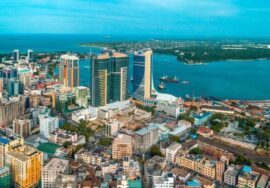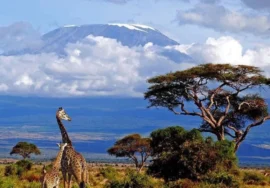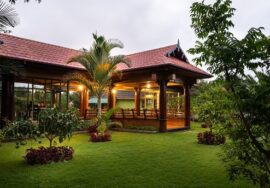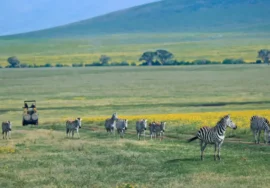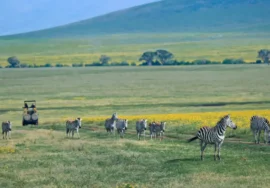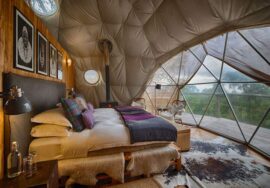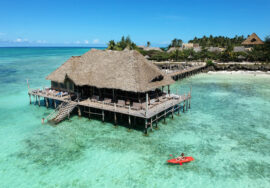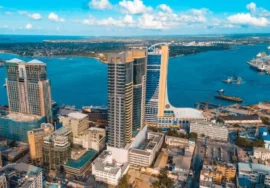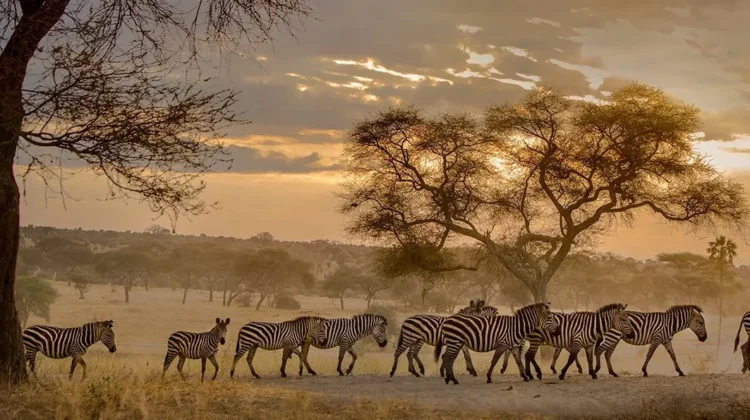
Northern Tanzania Safari
Northern Tanzania Safari, Located in northern Tanzania, the well-known “Northern Circuit” safari provides visitors with some of the most varied safari experiences available anywhere in the world. This safari is comprised of National Parks, game reserves, conservation zones, and private concessions. These include the world-famous and renowned Serengeti National Park and Ngorongoro Crater, as well as its less well-known neighbors, Tarangire National Park and Lake Manyara National Park. Both of these parks are located in Tanzania.
The establishment of these parks serves a single overarching objective, which is to safeguard the remarkable assortment and amount of wildlife that can be found inside them, including both permanent and seasonal species, and most importantly, the biggest yearly migration of wildebeest and zebra in the world. Despite the fact that this region of the world has gotten increasingly busy as a result of its fame, it is still feasible to locate a peaceful spot and escape the crowds if you are aware of where to go.
Northern Tanzania: Where is it located?
One of the things that should be on everyone’s travel bucket list is a safari in northern Tanzania. The Great Migration in the Serengeti National Park is one of the most incredible wildlife shows that can be seen anywhere in the world. On the other hand, a safari on the floor of the Ngorongoro Crater, which is located on the crater floor of the extinct volcano at Ngorongoro, is a setting that is unparalleled in terms of game viewing.
Kilimanjaro, the tallest freestanding mountain in the world and possibly the most difficult task in Africa, serves as a towering presence above everything else. Away from the popular tourist destinations, more tranquil parks like Tarangire National Park offer excellent opportunities to observe wildlife, but they are frequently overlooked in comparison to their more well-known neighbors.
There are Hadzabe tribes that call the lakes of Eyasi and Natron in the Rift Valley their home. These lakes also serve as the breeding sites for the greatest flocks of flamingos on the planet. There are a lot of people who consider a safari in Northern Tanzania to be the best safari of all time.
The northern safari circuit in Tanzania is often considered to be the most renowned safari location in all of Africa. In addition to the less well-known parks of Lake Manyara and Tarangire, this region is home to the world-famous Serengeti National Park and Ngorongoro Crater. The sheer concentration of Africa’s big game in this region is beyond anything that has ever been seen before.
The Serengeti National Park and the Ngorongoro Crater are the focal points of the majority of itineraries that are intended to visit this region. The Wildebeest Migration and the enormous concentrations of predators in the Serengeti are the primary attractions, while the Ngorongoro Crater offers visitors the opportunity to see all five elephants. In addition to being one of the most visually stunning and culturally diverse regions on the continent, this region is also home to a wide range of distinct civilizations, such as the Maasai and the Hadzabe.
A safari in the northern region of Tanzania or one in the southern region?
The question is whether you should go on safari in the north or the south of Tanzania, and how long you should spend on safari. You are going to have to make this decision first, as it is the most significant one. The parks that are located on the southern Tanzania safari are significantly different from those that are located on the northern safari, and each of these parks has both pros and disadvantages:
Although the parks in southern Tanzania are more remote, they are easier to get because there are daily flights departing from Dar and those flights do not require any stopovers. The campers in the south provide a greater variety of activities, such as walking, boating, and fly camping, and they are more intimate than the camps in the north.
Additionally, the southern camps give a better value for the money. The viewing of the game takes place in cars with open sides, which makes the experience more enjoyable. The southern region is known for its preference for shorter safaris and beach combos, which results in an experience that is not only swift and inexpensive but also extremely gratifying, with relatively few other tourists present.
On the other hand, the majority of parks in the north require closed-sided cars, do not permit walking safaris (with the exception of certain camps), and don’t permit boating safaris. Furthermore, the bulk of the places are extremely crowded and not as “wild” as they could be. You can discover little tented camps that are tucked away from the busier locations if your budget allows it and you know what you are doing. The majority of the tent and lodge alternatives are huge and lack character.
However, if you know what you are doing, you can find these camps. On the other hand, the benefits in the north include the Big Five, the Great Wildebeest Migration, and the breathtaking scenery; nevertheless, you should be aware that prices are often higher and that the value for money is lower in the low- to mid-range.
Logistical Support for a Northern Circuit
This, like any other trip destination, offers a wide range of possibilities, the majority of which are determined by your financial constraints. You are getting exactly what you pay for in this instance, which is a rare occurrence.
Those who are interested in luxury travel can take advantage of the Beyond Flying Circuit, which does not need them to drive between camps in any way. An example of this kind of safari might consist of spending two nights at the Lake Manyara Tree Lodge, two nights at the Ngorongoro Crater Lodge, and anywhere from two nights at Serengeti Under Canvas and/or Kleins Camp to any number of nights. This trip is absolutely fantastic and luxurious. The addition of one or more of Singita’s camps in Grumeti Reserves, such as Faru Faru, Sasakwa, or Sabora, would be the cherry on top of the cake.
A mid-range northern circuit would consist of traveling between Arusha, Lake Manyara, Tarangire, and the Ngorongoro Crater and Highlands. This circuit is by far the most popular one that we sell. This would be followed by a flight to one of the smaller tented camps located in a distant and tranquil region of the Serengeti, where there are a significantly lower number of people. This type of safari is more cost-effective than the high-end safaris, and it does not necessarily have an effect on the quality of your game viewing experience. You save money by driving (rather than flying) the first part of the circuit, but you then fly to wherever the migration is taking place in the Serengeti.
One of the most cost-effective safaris is a full driving circuit that is conducted in the traditional manner. This safari includes your very own private driver-guide who will accompany you during the entire journey. When there are more of you around to split the expense, this becomes an exceptionally cost-effective option. A private safari is the only type of safari that we book, and we plan the park combinations based on the season.
Being able to stay in less expensive hotels that do not supply their own safari cars is one of the advantages of having your own vehicle. Additionally, your own driver-guide will be ready to show you the finest of the region each day if you have your own vehicle while you are on safari. The disadvantage of this type of circuit, on the other hand, is that you are restricted to staying in the larger lodges that are located in the busier regions of the parks. This is a bit of a disappointment for the Serengeti because it is not always certain that you will see the migration.
It is well knowledge that the northern parks provide a very restricted selection of activities, and in the majority of instances, you are only able to go on game drives during the day. There is, however, some variation in this regard from one park to the next. Additionally, private concessions may occasionally have some leeway and may be able to provide night drives and walking opportunities.
Game drives are only available during the daytime hours in the Ngorongoro Crater. If you are staying at one of the hotels that are located on the crater rim itself, you may occasionally be able to go on a brief bush walk around the property. Additional sports, such as mountain biking, horseback riding, and hiking, are available at the hotels that are located in the Ngorongoro Highlands region.
Game drives are only available during the daytime in the Serengeti National Park, unless you are staying in the Kogatende district, which is located in the far north of the park. In this region, certain lodges, such as Alex Walker’s Serian and Serengeti Lamai, offer walking safaris in only certain regions. As a result of their private nature, Kleins Camp and the Singita properties located in the Grumeti reserve provide opportunities for nighttime drives and walking.
Due to the fact that Lake Manyara National Park is so compact and easily accessible, visitors can go on game drives throughout the day or even at night, depending on where they are staying.
When it comes to activities, Tarangire National Park is the park with the largest variety. Olivers Camp and Swala, both located within the park, provide opportunities for walking safaris and night drives, in addition to bush nights, during which you can camp out under the stars. In addition, these can be found at the camps that are located outside of the park, albeit in a place that is less appealing.
Eyasi and the southern parts of the region provide the option to hunt with the Hadazbe, and the neighboring areas, such as Empakai, Lake Eyasi, Mount Meru, and Kilimanjaro, offer the obvious opportunities for walking and trekking.
To what extent does a safari in Northern Tanzania cost?
The prices of the northern camps are extremely variable, and as a general rule, the greater the price, the more enjoyable your experience will be at the camp and interacting with the game. On the lower end of the spectrum are the huge permanent lodges such as the Serena and the Sopa.
These lodges have anything from seventy rooms to ninety rooms, and their prices range from approximately five hundred dollars per person per night, which includes game activities. This is quite common for all of the parks. However, there are smaller tented camps in the Serengeti, such as Kati Kati, that fall into this price range. These camps are located in locations that are just as filled with people.
There are other fantastic mobile tented camps available in the mid-range options, such as Olakira, Dunia, and Ubuntu, which cost approximately $650 per person per month. One of the most significant benefits of these camps is that the majority of them relocate every four months in conjunction with the migration. This allows them to avoid crowds, create a more personal camp ambiance, and provide a higher quality gaming experience.
The Alex Walker Serian is priced at $850 per month and is without a doubt the best mobile operation in the Serengeti. However, due to the manufacturer’s numerous special offers, this product falls into the category of being in the middle of the pricing range. The Plantation Lodge or Gibbs Farm in the Ngorongoro Highlands, both of which cost approximately $650 per person per night, are excellent options for these camps since they provide tourists with access to the Crater and Manyara while avoiding the major hotels.
Operators like as &Beyond and Singita, which begin at $1,000 per month and go up to $1,600 per month, are located at the upper end of the spectrum. After that, there is Serengeti Lamai and Sayari, both of which cost approximately $900 per person per month. It is worth every penny to purchase the higher-end product because it provides a safari that is actually of world-class quality, provided that money is not a major concern.
If you would want an overview of the best places to stay in the Serengeti, please click on the link provided.
An off-the-beaten-path safari across the northern region of Tanzania
Observing wildlife in the northern parks is restricted to closed-sided vehicles, with a few notable exceptions. Walking is not permitted in these areas. However, it is now feasible to take good safari walks in the Serengeti with members of the Serian and Nomad communities from their mobile camps, as well as from Sayari and Serengeti Lamai in the Lamai Wedge. These treks are brief, but they are enjoyable.
Assuming that you are interested in walking or hiking in an appropriate manner, it is highly recommended that you venture off the usual path, away from the National Parks, and into concession areas that are less strictly regulated. The areas surrounding Nduara Camp in the Loliondo region and the Hadzabe hunter-gatherers in the vicinity of Eyasi are the most suitable for walking among these choices. In addition, there are wonderful guided treks to the top of the Great Rift Valley escarpment, which overlook Manyara. These walks are frequently led by Maasai residents.
A Circuit Through Northern Tanzania: Instructions on How to Do It
The city of Arusha, which was previously a traditional Maasai settlement, serves as the starting point for a safari in the northern region. Foreign flights arrive either through Dar, which is a two-hour flight from Arusha, or Kilimanjaro, which is only a half-hour drive away. Both of these airports are accessible by car. You can begin your northern safari by taking a short flight from Arusha to any of the parks, or you could instead choose to drive there.
Additional Reading: A Safari in the Northern Region of Tanzania
If you would like some further background information, you can read the Cadogan Guide to Tanzania and Zanzibar – Northern Circuit Chapter, which was prepared by one of our directors, Annabel. While we are working hard to make our website as comprehensive as possible, if you would like some additional information, you can consider reading it. It is possible that some of the information may be slightly out of date because the most recent version was released in 2005; but, in general, it is as comprehensive as they come.
Tanzania is not the only country that we are familiar with!
The most effective way to acquire additional information about Tanzania is to give us a call and have an objective conversation with us. Although we have a strong affinity for Tanzania, we also have a strong affinity for the rest of Africa and have specialists in all of the major safari countries. We would appreciate it if you could send us an email or give us a call if you are still unsure about where you would like to go.

